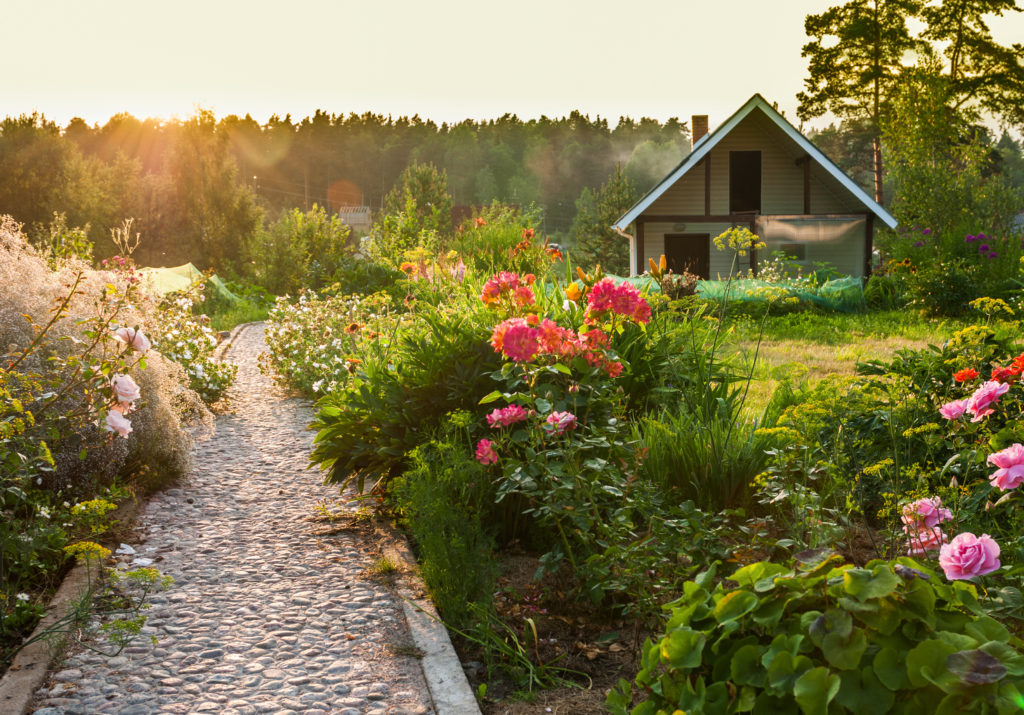Home gardeners can be the planet’s best friend or its worst enemy. Excess fertilizer use, overwatering, and pesticides can all damage the environment. But the right garden plants can provide shelter and food for wildlife and pollinators and act as a significant force for good. Here are gardening practices that will accomplish this goal:

Eliminate or Reduce Lawn
Grass uses large quantities of water and is labor intensive. A perfect lawn is expensive in environmental terms. Pesticides and herbicides can contaminate the water table, and large quantities of water are required to keep the golf course look. While turf may be the best solution for play areas and high traffic areas, it should be reduced or eliminated elsewhere. Where lawn cannot be eliminated, use a mulching mower to return grass clippings to the turf. The clippings help to shade the turf, provide natural fertilizer and reduce the need for chemicals, and are not a significant source of thatch buildup.
Have a Soil Test Done, and Add Fertilizer Only Where Needed
Dozens of homeowners over-fertilize their lawns and gardens, causing damage to waterways. Fertilizer runoff from lawns causes algal bloom in rivers and lakes, killing fish and other aquatic life.
Plant Natives Whenever Possible
Native plants are well adapted to the local climate, and provide habitat for birds, butterflies, and wildlife. They are usually easier to grow than non-natives.
Identify and Remove Invasive Species
Invasive plants like English ivy can crowd out desirable plants, reducing biodiversity and killing trees. Your local extension agent can help you identify invasives. Whenever possible, remove invasive plants by hand-pulling. Herbicides may fail to eliminate the problem, and may cause damage to desirable species.
Mulch Plants to Conserve Water
Organic mulches are best, since they break down and improve soil texture while adding nutrients. Mulch holds moisture in the soil and reduces the need for watering. It also suppresses weeds and helps to keep plants from heaving out of the ground in winter. Many municipalities provide free mulch to their residents.
Group Plants into Hydrozones
Plant drought-tolerant plants with others requiring the same conditions, and plant those requiring higher moisture together for easy maintenance and less water waste.
Start a Compost Pile, and Add Organic Matter to Your Soil
Adding organic matter helps soils hold moisture, improves their texture, and reduces water usage. Composting your vegetable scraps will also add nutrients to your soil and reduce the need for chemical fertilizers.
Grow Only as Many Vegetables as You Can Consume, and Consider Growing Herbs
Vegetable growing uses large quantities of water and fertilizer, and is relatively high-maintenance. A culinary herb garden makes an attractive, edible alternative to a vegetable garden and is much simpler to maintain. Most herbs require very little fertilizer and water, and many are exceptionally beautiful. They’ll give you the most flavor per square foot, making everything you cook taste better. And given the high price of fresh-cut herbs in the grocery store, an herb garden saves a great deal of money.
Use Porous Paving Systems
Porous pavers allow water to remain in the soil, instead of flooding low-lying areas. Large quantities of concrete and other non-porous materials contribute to flooding problems in many low-lying urban and suburban areas.
Prefer Fruits that Don’t Require Spraying
Unusual choices like pawpaw, medlar, and fig are often superior to apple and cherry trees that may require extensive spraying for maintenance.
Start a Rain Garden
If you live in an area of high precipitation, try installing a rain garden. Rain gardens trap water and supply it to moisture-loving plants, instead of allowing it to run off into the sewer systems.
Instructions are available on many garden websites and in books on ecological gardening.
Saving the Planet and Saving our Backs—One Garden at a Time
Following earth-friendly practices will give you the easiest, lowest-maintenance garden you’ve ever had. With so many advantages, why would you even think of going back to the old back-breaking garden methods?







